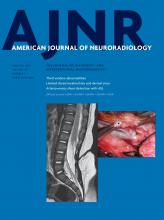Research ArticleNeurointervention
Open Access
Flow Diverters in the Treatment of Pediatric Cerebrovascular Diseases
M. Barburoglu and A. Arat
American Journal of Neuroradiology January 2017, 38 (1) 113-118; DOI: https://doi.org/10.3174/ajnr.A4959
M. Barburoglu
aFrom the Department of Radiology (M.B.), Istanbul University Medical School, Istanbul, Turkey
A. Arat
bDepartment of Radiology (A.A.), School of Medicine, Hacettepe University, Ankara, Turkey.

References
- 1.↵
- D'Urso PI,
- Lanzino G,
- Cloft HJ, et al
- 2.↵
- Takemoto K,
- Tateshima S,
- Golshan A, et al
- 3.↵
- Appelboom G,
- Kadri K,
- Hassan F, et al
- 4.↵
- Burrows AM,
- Zipfel G,
- Lanzino G
- 5.↵
- Lubicz B,
- Collignon L,
- Raphaeli G, et al
- 6.↵
- 7.↵
- 8.↵
- 9.↵
- Abla AA,
- Zaidi HA,
- Crowley RW, et al
- 10.↵
- Kan P,
- Mokin M,
- Puri AS, et al
- 11.↵
- 12.↵
- 13.↵
- 14.↵
- De Vries J,
- Boogaarts J,
- Van Norden A, et al
- 15.↵
- Derakhshani S,
- Rosa S,
- Low S, et al
- 16.↵
- Hetts SW,
- Narvid J,
- Sanai N, et al
- 17.↵
- 18.↵
- 19.↵
- 20.↵
- 21.↵
- Brinjikji W,
- Murad MH,
- Lanzino G, et al
- 22.↵
- Shankar JJ,
- Tampieri D,
- Iancu D, et al
- 23.↵
- Chalouhi N,
- Tjoumakaris S,
- Starke RM, et al
- 24.↵
- 25.↵
- 26.↵
- Arnold M,
- Steinlin M,
- Baumann A, et al
- 27.↵
- Waitzman AA,
- Posnick JC,
- Armstrong DC, et al
- 28.↵
- 29.↵
- He L,
- Ladner TR,
- Pruthi S, et al
- 30.↵
- Sanon S,
- Gulati R
- 31.↵
- 32.↵
- Chandela S,
- Alzate J,
- Sen C, et al
- 33.↵
- 34.↵
- 35.↵
- 36.↵
- Gupta V,
- Jain V,
- Mathuria SN, et al
- 37.↵
- Gralla J,
- Brekenfeld C,
- Schmidli J, et al
- 38.↵
- 39.↵
- 40.↵
- Lee JY,
- Kwon BJ,
- Kang HS, et al
- 41.↵
- 42.↵
- 43.↵
- 44.↵
- 45.↵
- Mertens L,
- Eyskens B,
- Boshoff D, et al
- 46.↵
- Li JS,
- Yow E,
- Berezny KY, et al
- 47.↵
- 48.↵
- Delgado Almandoz JE,
- Kadkhodayan Y,
- Crandall BM, et al
- 49.↵
- 50.↵
- 51.↵
- Giglia TM,
- Massicotte MP,
- Tweddell JS, et al
- 52.↵
- Arat A,
- Daglioglu E,
- Akmangit I
- 53.↵
- 54.↵
- 55.↵
- Colby GP,
- Lin LM,
- Nundkumar N, et al
- 56.↵
- Attali J,
- Benaissa A,
- Soize S, et al
- 57.↵
- 58.
- Halimeh S,
- Angelis G,
- Sander A, et al
In this issue
American Journal of Neuroradiology
Vol. 38, Issue 1
1 Jan 2017
Advertisement
M. Barburoglu, A. Arat
Flow Diverters in the Treatment of Pediatric Cerebrovascular Diseases
American Journal of Neuroradiology Jan 2017, 38 (1) 113-118; DOI: 10.3174/ajnr.A4959
0 Responses
Jump to section
Related Articles
Cited By...
- Braid stability after flow diverter treatment of intracranial aneurysms: a systematic review and meta-analysis
- Bioresorbable flow diverters for the treatment of intracranial aneurysms: review of current literature and future directions
- Treatment of pediatric intracranial aneurysms: case series and meta-analysis
This article has not yet been cited by articles in journals that are participating in Crossref Cited-by Linking.
More in this TOC Section
Neurointervention
Similar Articles
Advertisement











